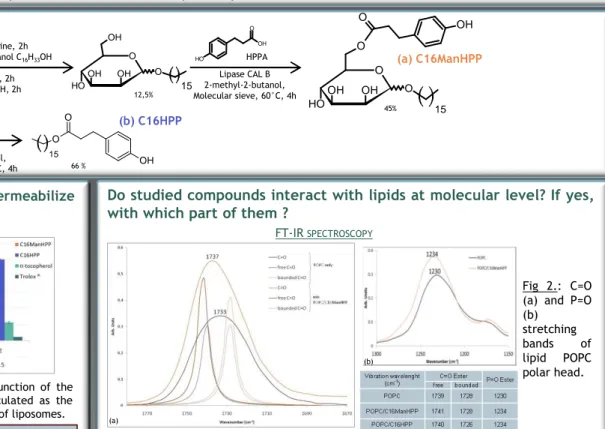Biophysical characterization of the interaction of
novel aromatic glycolipid surfactants with membrane models.
P. Sainvitua,b, M.N. Nasira,b, F. Dragueta,b, K. Nott a,c, L. Linsb, J.-M. Crowetb, L. Willemsd, J.-P. Cossed, C. Jérômee, M. Deleua,b.
a Department of Industrial and Biological Chemistry, bCenter of Molecular Numeric Biophysics, cDepartment of General and Organic Chemistry, dMolecular and Cellular Biology lab,
Gembloux Agro-Bio Tech, University of Liege, Belgium, eCenter for Education and Research on Macromolecules, University of Liege, Belgium
We thank the Belgian French Community – Concerted Research Actions – Wallonia - Europe Academy for financial support.
MD and LL thank the FNRS for their position as research associate and senior research associate, respectively.
Amsterdam, May 15-16th 2013
AcknowledgmentsReferences 1Otto, 2000, Journal of Molecular Catalysis B: Enzymatic 8, 201-211. 2 Brasseur, 1990, CRC Press: Boca Raton, FL, Vol. 1, 203−219. O OH O H OH OH OH O OH O H OH O O OH O 15 O O OH 15 OH 15 O O H OH O OH O H OH O OH 15 Lipase CAL B 2-methyl-2-butanol, Molecular sieve, 60°C, 4h 1) Ac2O, Pyridine, 2h 2) 1-Hexadecanol C16H33OH 3) BF3, CH2Cl2, 2h 4) NaOH, MeOH, 2h (a) C16ManHPP (b) C16HPP HPPA Mannose
S
YNTHETIC PATHWAY
Do studied compounds permeabilize
liposomes?
O OH O H Lipase CAL B 2-methyl-2-butanol, Molecular sieve, 60°C, 4h HPPAAt a ratio lipid/ studied compds around 1, both synthesized compounds have an action on liposomes and reference molecules not.
Do studied compounds interact with lipids at molecular level? If yes,
with which part of them ?
Fig 2.: C=O (a) and P=O (b) stretching bands of lipid POPC polar head. FT-IR SPECTROSCOPY PERMEABILITYASSAY 12,5% 45% 66 %
The interaction between the lipid and the studied compounds is confirmed by the infrared spectroscopy and the molecular modeling. The two techniques highlight interactions involving polar parts of the molecules
I
NTRODUCTION
The two synthesized compounds are able to interact with membrane lipids and more particularly with the polar head of phospholipids. These interactions induce permeabilization of the bilayer at high concentration and could explain their cytotoxicity. The presence of a sugar unit in the molecule increases these effects.
The interaction between synthesized compounds and cell membrane may cause damages leading to cell death.
C
ONCLUSIONS
Fig 3.: Molecular assembly of C16ManHPP and C16HPP with POPC, a lipid representative of eucaryotic cell membranes. Calculated according to the Hypermatrix method2 . MOLECULARMODELINGFig 1.:Permeability percentage in function of the ratio lipid/ studied compounds calculated as the release of the fluorescent probe out of liposomes.
Aromatic glycolipids are of both medical and pharmaceutical interest. Antimicrobial, antiviral and anti-inflammatory activities have been reported1. The
alkyl chain should enhance their ability to penetrate into the cellular membrane. The presence of a sugar unit could also be useful to target specific cells. In this study, a novel phenolic glycolipid and its derivative without the sugar unit were synthesized. Their interaction with model membranes was studied by several approaches. The relationships between these data and their cytotoxicity are discussed.
The shift of the bands characterizing the phospholipid confirms the interaction of both compounds with biomimetic bilayers. More particularly, the polar head of the phospholipid is involved. No significant shift of alkyl bands was observed indicating that the fatty chain is probably less implicated in the interaction lipid-compound.
CELLULAR
VIABILITY
ASSAY
What is the toxic concentration of studied molecules ?
Both synthesized compounds have an action on cells. They exhibit a toxicity at a concentration above 50 µM but reference molecules not.
Fig 4.: Cell viability after incubation of human cancer cells (HeLa) with synthesized compounds (C16ManHPP and C16HPP) (a) or reference molecules (Trolox and α-tocopherol) (b). The test is based on the bioreduction of MTS into formazan. => Upper than 20 µM for C16ManHPP and 50 µM for C16HPP
(a) (b) The interaction energies calculated between the synthesized compounds and the POPC lipid are highly favourable (more for C16ManHPP than for C16HPP). (a) (b)
